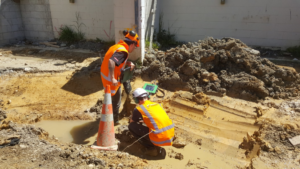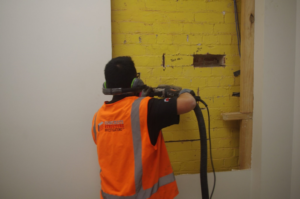As an earthquake-prone country, New Zealand properties are strictly assessed based on their capabilities to withstand moderate to strong earthquakes. […]
As an earthquake-prone country, New Zealand properties are strictly assessed based on their capabilities to withstand moderate to strong earthquakes. These are rated by using two levels of assessment, Initial Seismic Assessment (ISA) and Detailed Seismic Assessment (DSA).
These data assessments are widely considered as one of the major documents needed by Commercial Property Agents that will be presented to their prospective occupiers/purchasers. Meanwhile, Engineers use these seismic assessments of existing buildings to provide a technical basis for strengthening properties in specific areas.
Concrete Structure Investigations (CSI) Ltd is well-known in the field of non-destructive testing (NDT) on the construction sector throughout New Zealand and is able to provide assistance in these assessments.

Figure 1 Pile Integrity Testing (PIT) to assess deep foundation compliance
The most obvious source of information for earthquake assessments for existing buildings would be structural drawings for which the building was built according to. However, considering the age of most buildings being assessed, often these drawings and other specifications are not available anymore, or may not include subsequent alterations. Moreover, then as now, buildings are not always built according to the plans!
Where there is missing information about the existing building crucial to the assessment, or when it is suspected that the actual built condition differs from the specifications, CSI can help in collecting the information through their range of services.
A lot of concrete and unreinforced masonry (URM) buildings have been the subjects of earthquake rating assessments. These URM buildings are structures that have been built prior to 1935. The list of collapse risks of URM buildings is quite long. The most common parts that need to be assessed on these heritage buildings are cavity wall connections, wall-diaphragm connections, and wall-to-wall connections.

Figure 2 Brick extraction for strength testing
It is important to note that foundations are an integral part of any structures and should be regarded as a potential structural weakness to be included in the assessment. Regardless of the strength of the whole structure, poor detailing or failure in constructing compliant foundations may result in a life-safety hazard.
With all these detailed assessments at hand, property agents and purchasers alike will have informed decisions regarding the property they are trying to buy or sell.
Looking to find out more about the structural integrity of a building you have an interest in? Contact the team at CSI on Email: info@csiscan.nz or phone: 0800 33 77 67.
And if you are really keen, have a read of the full technical paper loaded on our premium content page – note you need to login (or sign up to get a login) first to access premium content.
Leave a Reply
You must be logged in to post a comment.